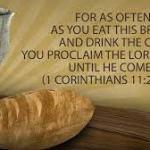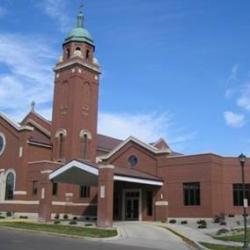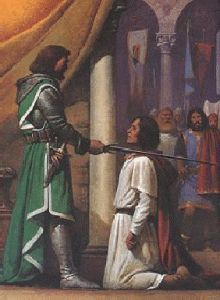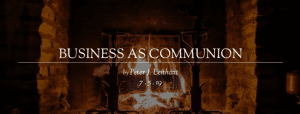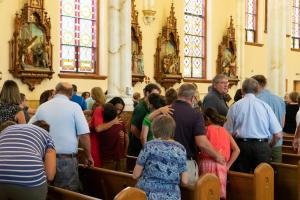
One of my favorite images of the Church, from before the Second Vatican Council, is the Mystical Body of Christ. I was disappointed when the Second Vatican Council put People of God instead of Mystical Body in first place among its many images. But Church as Mystical Body gets some rough treatment in Cavanaugh’s fifth chapter. The Church, Cavanaugh says, is not a mystical presence behind the bodies in the real world. It is a bodily presence in that world, the True Body of Christ.
On Chapter Five of Torture and Eucharist: Theology, Politics, and the Body of Christ, eighth in the series on William T. Cavanaugh. He is a Catholic theologian who writes about the Church and its role in culture, politics, and economics. Introduction to Cavanaugh and links to blogs in the series as they appear are here.
True Body and Mystical Body changing places
It should be obvious from the Incarnation that God means to be an effective, not just a mystical, bodily presence in the world. Henri de Lubac did the historical spadework behind Cavanaugh’s analysis. He found that the term “Mystical Body” originally referred to the Body of Christ in the sacrament of the Eucharist. The Church in its earlier self-concept was “Corpus Verum” — True Body of Christ (p. 212).
The 12th century saw these two terms change places. The Eucharist became “Corpus verum.” A hymn by Pope Innocent VI planted that image of the Sacrament of the Altar firmly in the Church’s liturgy. I used to love that hymn —
Ave Verum corpus natum… Hail true Body, born of the Virgin Mary.
The song and the new theology make a very close connection between the consecrated bread and cup of the Eucharist and the body of Jesus, who lived and died 2000 years in the past. The Church, which Paul said is also the body of Christ, is connected, too, but more distantly, now as a body in a mystical sense.
Cavanaugh references de Lubac again:
[M]ystical body ecclesiologists of the twentieth century had a regrettable tendency to set up a dichotomy between on the one hand, the external, institutional church, and on the other hand, the body of Christ which is ‘interior,’ ‘hidden,’ ‘invisible’ — all aspects which came to be associated with the term ‘mystical.’ (p. 210)
But the Eucharist is not hidden and invisible. It is a very tangible building up of the visible body of the Church in and for the world. Christ isn’t any less present in the Eucharist for being mystical, but that presence has a different orientation. It’s less a re-presentation of the past (though it is that) and more an anticipation and foretaste of the fullness of Christ in the future.
De Lubac held that
... Christ’s gift of his body and blood under the material signs of bread and wine renders impossible any dichotomy between the earthly and the heavenly, the material and the spiritual, or the body and the soul. (p. 225)
Space and time images
That dichotomy is what a state prefers. It gives the state all the territory it needs and cordons off the Church into a separate space. It doesn’t matter to the state if that space is higher, as long as it doesn’t interfere.
The true difference between state and Church, however, is not one of space but of time. The state imagines a featureless time that just keeps going on and on, no matter what happens in it. The Church conceives the same time as qualitative, with a beginning and definite high points and an ending, or goal. For instance, the time that the Church occupies leads from the first to the second coming of Christ. Time is eschatological. This future eschaton, end point or goal, gives meaning to the present.
With that end point in mind, the Church can interact meaningfully with the state and, perhaps, even make a difference. For a long time, including as I was being introduced to theology, the Church’s thinking about the end had little to do with the world in the present. Eschatology was a minor theme, coming at the end of typical theology textbooks. It covered the “Four Last Things” — death, judgment, heaven, hell. It all seemed very remote from earth, to which Scripture says Jesus will return. In the daily prayers of the Mass with which I grew up,“there is not a single allusion to [Jesus’] second coming.” (p. 226)
Pius XII, while championing the Church as Mystical Body, also emphasized the Church as institution in the world, especially the hierarchy with himself at the head. (Of course, Christ would be the head of the Mystical Body.) As an institution the Church was powerless to keep its members from killing each other. This was 1943, the darkest times of the Second World War. Such conflict had no place in the mystical realm of the soul, but then that mystical realm, because it was only mystical, couldn’t stop the killing either. Cavanaugh says the doctrine of the Mystical Body
… masks, rather than witnesses against, the violence of nations. (p. 212)
Conclusion
Cavanaugh summarizes his Chapter 5 this way:
In this chapter I have tried to display how the Eucharist builds a visible social body capable of resisting the state’s strategy of disappearance. The Eucharist anticipates the future Kingdom, re-members Jesus’ conflict with the powers of this world, and brings both future and past dimensions of Christ into the present in the form of a visible body. The result is a “confusion” of the spiritual and the temporal, an invasion of worldly time and space by the heavenly, and thus the possibility of a different kind of social practice. (p. 251)
My thinking about the Eucharist has had to change a little. I’m thinking now about the dismissal at the end of Mass. It has changed recently, and at first I wasn’t sure I liked it. The priest or deacon used to say, “Go in peace to love and serve the Lord.” Now I’ve started hearing simply, “Go in peace.” What happened to loving and serving the Lord? Well, that’s what we’ve been doing for the last hour. It’s not something that starts after Mass is over.
As Cavanaugh says there’s a “confusion” of the spiritual and temporal. It’s as a true body in the world that we break open the Word of God and share bread and cup, binding ourselves together. We’re telling the world, “The Body of Christ is here in plain sight. That already makes a difference.”
Image credit: Holy Angels Catholic Church via Google Images



